Featured Artwork: “Find the Kitty in This Picture”, 1988
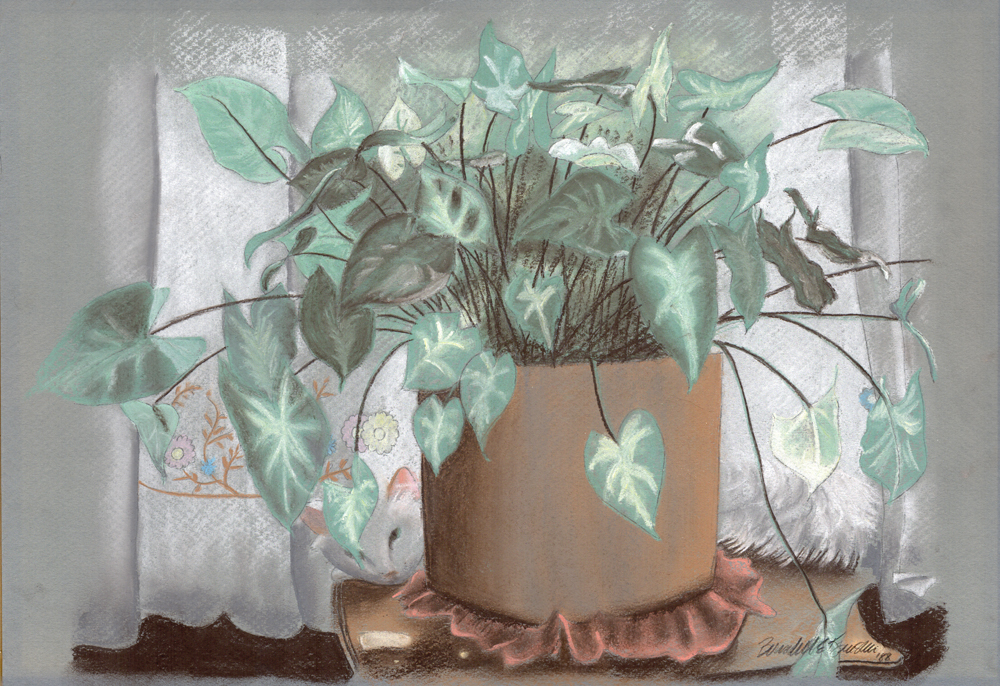
I’m going way back to my beginnings with this painting/sketch. It predates all of my pastels, but is actually my first work in color, when I decided to move from pencil to try to interpret some of the lovely colors I saw in the world around me, and especially in my cats.
In fact, this sketch isn’t even in pastel at all—I used colored chalk! I remember thinking at the time that I didn’t want to invest in those expensive pastels unless I knew I could produce something with them. How I would know when I could do that without actually using them I don’t know, but I think it had something to do with my level of confidence while I worked on the sketch, much the same as it had been when I worked in pencil. I could visualize the medium, I could visualize the sketch, getting that visualization on the paper was my goal, and in order to do that I had to work the medium and at least basically understand its properties.
Moving on to a new medium? As always, my cats led the way. When I put together my first portfolio book in 1993, I used a photo album with 3.5″ x 5″ photos of my works and often the reference photo and a paragraph of text along with the name and details of the work pictured, using my very first personal computer at home to design and print the information, then glue the photos in place. Ah, sweet memories, building my future. Here is what I had to say about this painting:
Sally can’t ever be too warm. This picture was taken during the summer when temperatures were consistently in the 90s and sometimes over 100 degrees, and this is a south-facing window. When I got this picture back, I wondered why I had taken a picture of this plant, then I saw her tail, and then her face. I hadn’t started working in color yet, so rather than invest in pastels right away, I used colored chalk to see how I would do. The experiment was enough to make me want to explore some more.
I remember that summer. It was two years before I moved into this house and at least that rented house was larger with far more cross-ventilation and a large cool basement, but the heat was brutal, a month of excessive temperatures in a year of drought, very unusual here in Western Pennsylvania. But Sally still spent time in her favorite sunny spots; at the time I had no idea about heat stroke or sunburn in a white cat with pink skin, so I’m glad Sally had a little bit of sense to move herself before she was in danger of roasting herself.
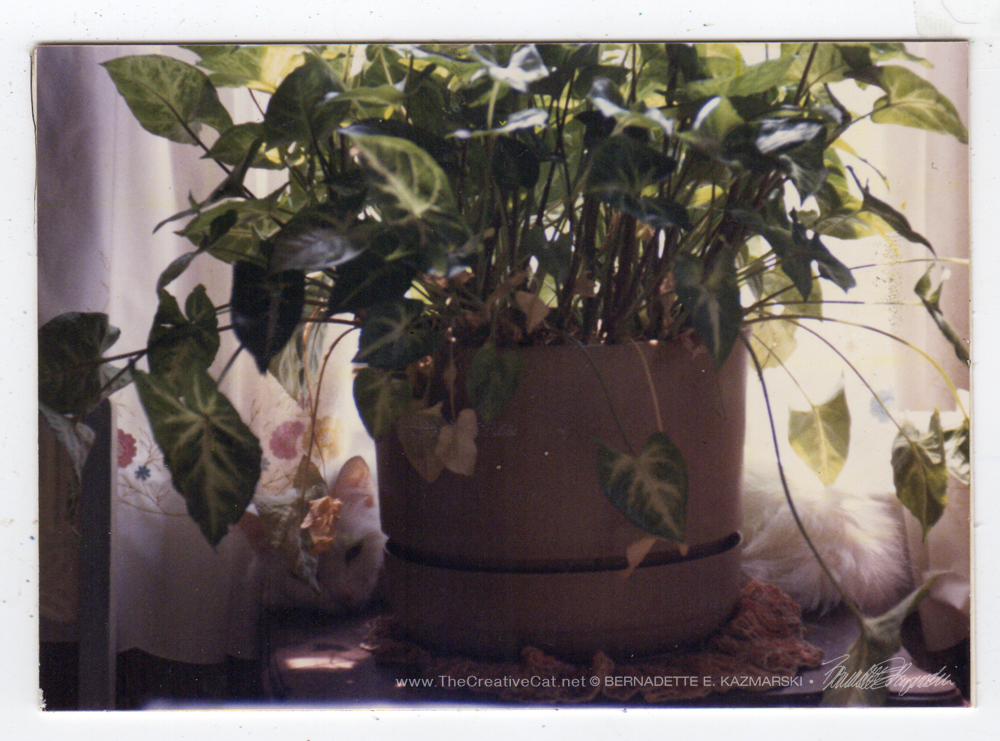
I remember looking at the photo when I got it back too. I remember my eyes kind of picking through it, pulling apart the details and planning how to put it together on paper, a process that is so much a part of my everyday life now after years of visualizing works, but was still pretty new then. And though I’d worked pretty much exclusively in pencil up to then, and this would have been a nice pencil sketch too, it was the delicate colors, the pink of Sally’s nose and ears, the wandering embroidered flowers on those curtains that I loved, the light through the curtains, and the light on the tabletop, that made me decide to try color. At first, I wanted to try watercolor but was intimidated by my total lack of knowledge and the materials I needed to purchase, plus the fact that between two jobs, cats, garden, and renovating this house I had little time to work so I wanted something that didn’t really require set up and preparation and clean up. There was no way I could paint in oils or acrylics to achieve what I saw, and I knew colored pencil wouldn’t work. I remembered pastels, looked at my big box of colored chalk. Possibly, if the subject had been my black cat Kublai instead of my white cat Sally my decision would have been different, but I decided that box of chalk would do to start with. That decision was what led me to working with pastels even today.
I had been working my weekend part-time job in the art store (in addition to my full-time job as a typesetter) since spring that year, and was learning framing as part of that job. I had a piece of gray mat board left over from some framing experiments with some of my pencil drawings, and decided that would be the perfect base for my experiment. Still feeling most confident with pencil, I outlined the scene onto the matboard in pencil, which you can see throughout the sketch. And then I started applying the chalk, figuring out how to apply the medium to the surface and let it do what it would so that it looked like what I was visualizing. But, really, this first attempt was largely like a paint-by-number with the sketch underneath and me concerned about coloring outside the lines and, at first, no blending. I look at that mess of leaves now and don’t want to get involved, but it was a huge challenge, then, and fun.

Chalk, however, is chalk, and though I had a big set of colored chalk none of them were dark enough to work the shadows. My pencils weren’t dark enough, and my charcoal was black, which wasn’t the right tone for the table and the shadows around…already I was seeing more color than I had when I’d started and thought all the shadows were black or shades of gray.
I had a 50% to 75% discount on materials at the art store, and decided to get a product that walked the line between my familiar pencils and the pastels I wanted to use without having to purchase a whole set—pastel pencils. I bought a dark brown one. Bold move.
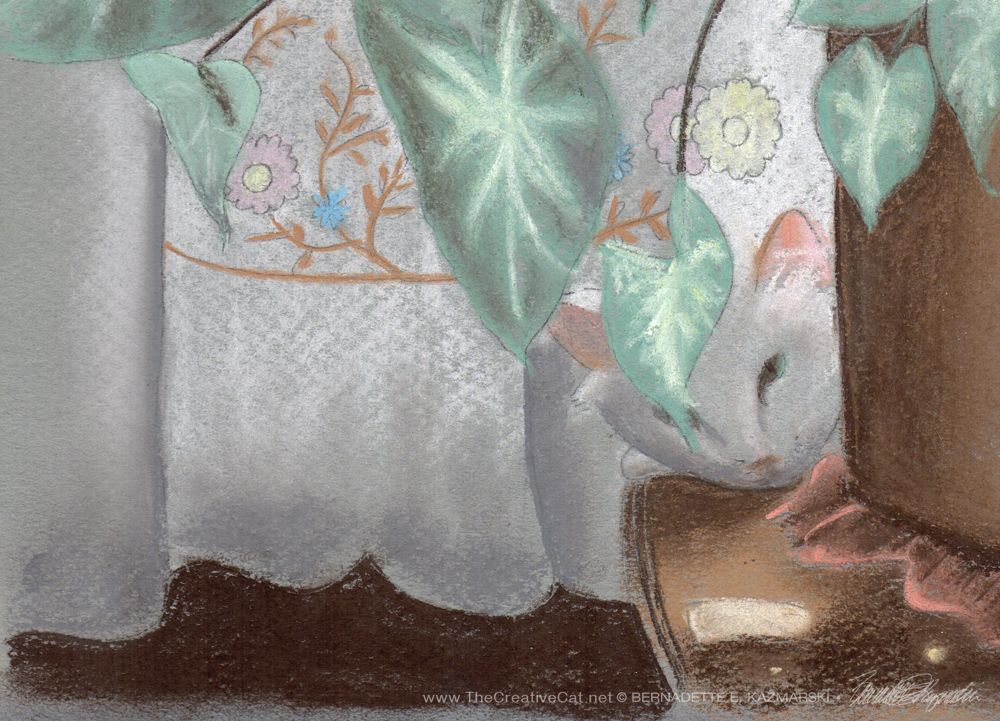
Much of it is pretty amateur, especially Sally’s face and tail, but I remember being pleased with the way some things worked out, feeling there was a point where it was actually finished but not perfect, and deciding that next time—there would be a “next time”?—I would to a few things differently, and I would also invest in a box of real pastels.
I still remember how exciting it was to see the image emerge from the gray matboard as if it was dimensional, so different from watching one of my pencil drawings develop; though they can appear dimensional as well and mine often did, the addition of color for the first time was breathtaking.
One of the elements of the scene I found very inspiring in addition to Sally and the curtain and the spots of light on the table is the one stray leaf that gracefully falls down in the lower right. I still find exciting little details like that in each painting, background elements that make the rest of the painting interesting. I didn’t know that then either.
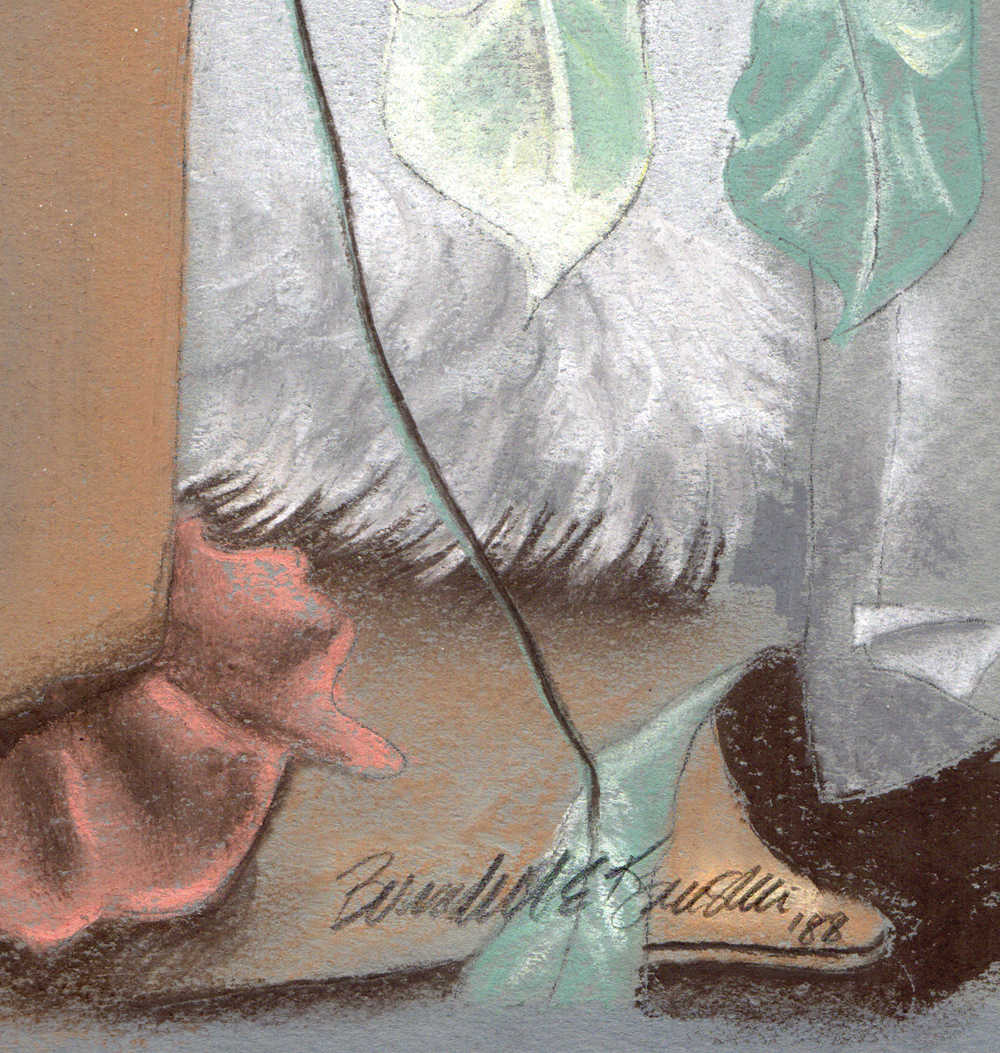
I didn’t sign my paintings then, not until a couple of years later, one of those odd humility things, feeling I didn’t deserve to sign my art, something I think every creative person moves through. In fact, I just signed it today, finally, when I removed it from the frame to scan.
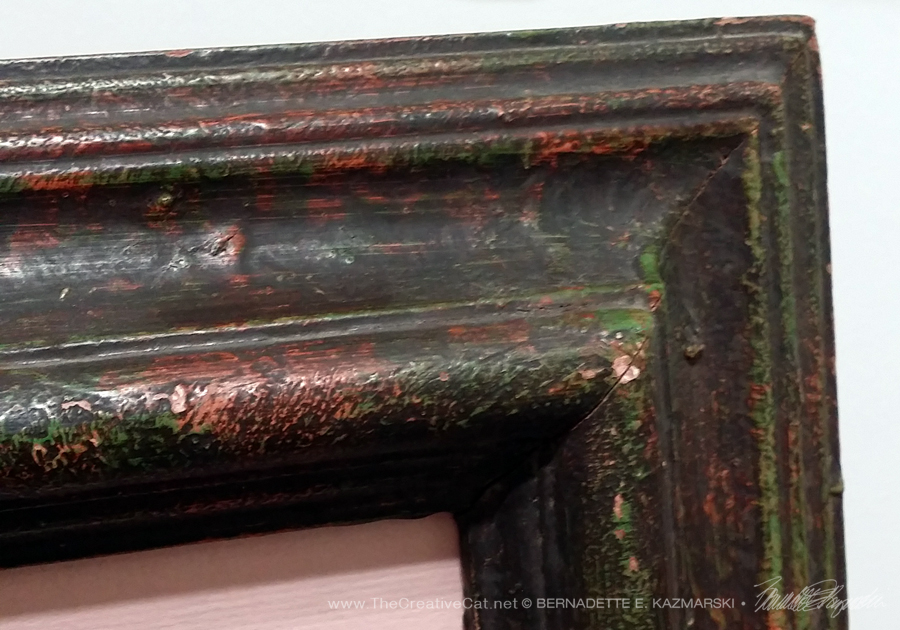
This painting has always hung in my bedroom, first in a plastic poster frame, and then in a frame I actually pulled out of someone’s trash and cleaned up that magically has a sponged finish including several of the darker colors in it. I look at the painting frequently, often visualizing the scene with today’s experience and knowing I’d do things very differently, but still with a lot of pride at what I accomplished in this early sketch. I also feel the memories of that time and place, smile at Sally and her ways, and look fondly at those curtains that I loved so much, the plant I’d pulled from the back room at the mall where I had worked and revived it, moving it from that house to here and having it until just a few years ago, those orange crocheted doilies that never ruffled right, the cheap mahogany-finish tables that had been my grandparents’ which I still use today, and think of that moment in time, the cats, how each of them came to me to form my first feline family, that house, the light, and how young I was. I also remember visualizing, suddenly seeing art everywhere, everything my cats did, the colors of flowers and how I would render them, and taking more and more photos.
This, of course, just a month or so later, led to “Waiting for Mom”, and the rest is history.
. . . . . . .
What is the difference between a “sketch” and a “painting”? Because pastel is a dry medium and not paint at all works have long been classed as drawings, and pastel works not considered “finished” or “final”, more like studies. But as pastel has become more popular and considered a medium in its own right, some works are also considered paintings. If a work covers the entire surface edge to edge in what is considered the image area, the work is considered a painting. If not, it’s considered a sketch. Of course, that can be subjective—many of the daily sketches I’ve done could be considered paintings because they fill edge to edge, but I’d still consider them sketches in part because that’s the way I think if them. But things evolve in our daily use, and art materials and works of art are among them.
Subscribe to my e-newsletter
Subscribe to The Creative Cat Preview E-newsletter.
 Subscribe to The Creative Cat on your Kindle
Subscribe to The Creative Cat on your Kindle

Start with a 14-day free trial. You can cancel at any time during the free trial period. If you enjoy your subscription, do nothing and it will automatically continue at the regular monthly price of 99 cents. Click here to subscribe to The Creative Cat on your Kindle.
All images used on this site are copyrighted to Bernadette E. Kazmarski unless otherwise noted and may not be used without my written permission. Please ask if you are interested in using one in a print or internet publication. If you are interested in purchasing a print of this image or a product including this image, check my Etsy shop or Fine Art America profile to see if I have it available already. If you don’t find it there, visit Ordering Custom Artwork for more information on a custom greeting card, print or other item.
© 2015 | www.TheCreativeCat.net | Published by Bernadette E. Kazmarski
—
Weekly schedule of features:
Sunday: Essays, Pet Loss, Poetry, The Artist’s Life
Monday: Adoptable Cats, TNR & Shelters
Tuesday: Rescue Stories
Wednesday: Commissioned Portrait or Featured Artwork
Thursday: New Merchandise
Friday: Book Review, Health and Welfare, Advocacy
Saturday: Your Backyard Wildlife Habitat, Living Green With Pets, Creating With Cats
And sometimes, I just throw my hands in the air and have fun!
—


B…before scrolling, it took me a minute to find sally 🙂 …this piece is beautiful !!!! ♥♥♥
That is a stunning poece of art work that you can be very proud of. My husband paints, but only in oils. We found the kitty in the top picture. So cute.